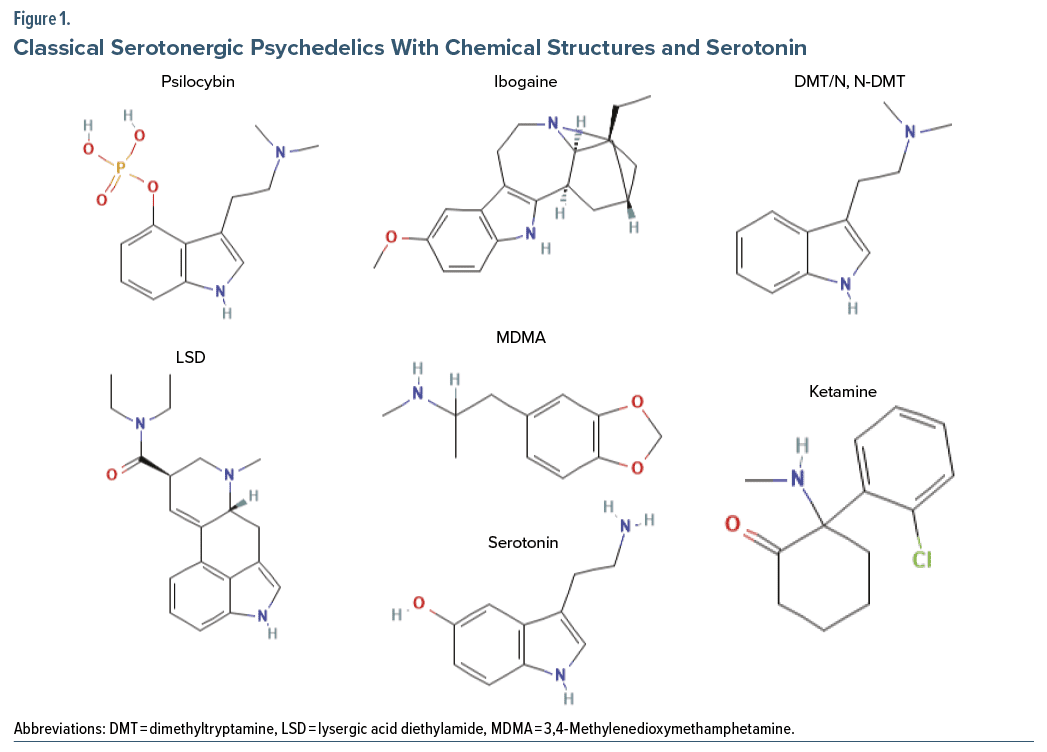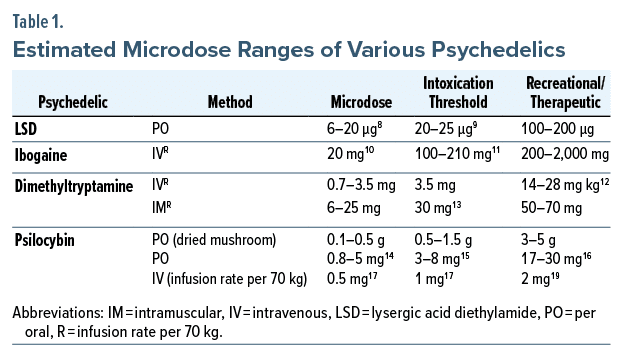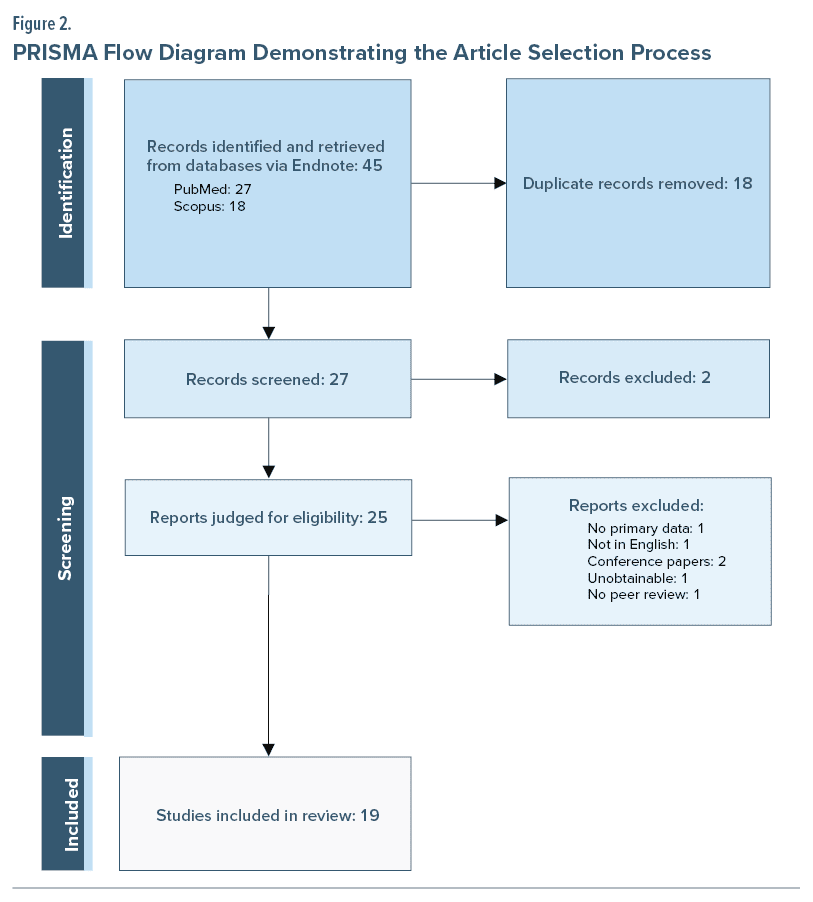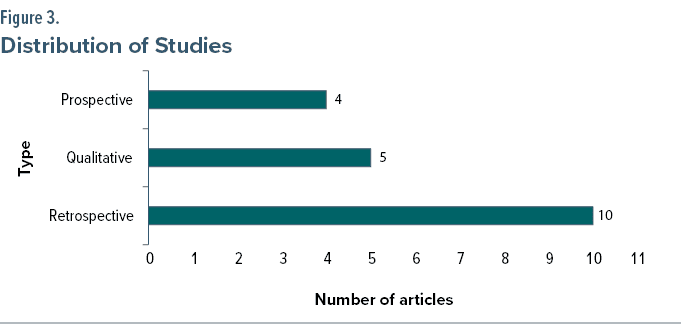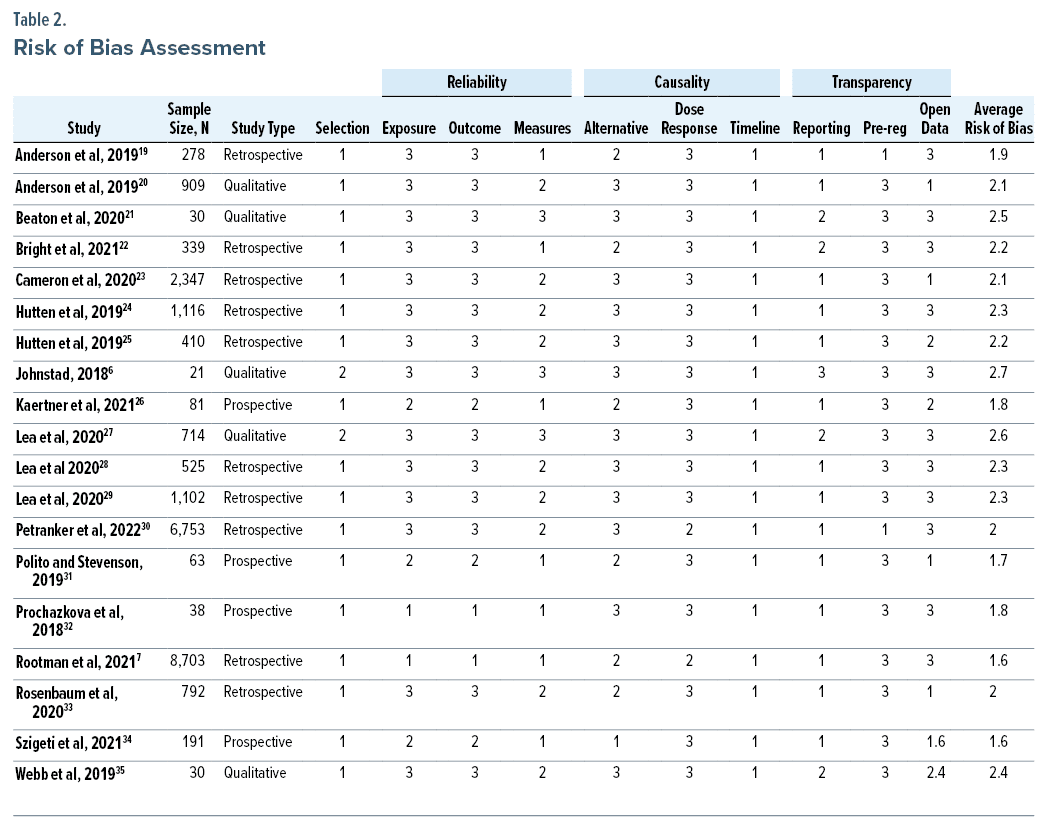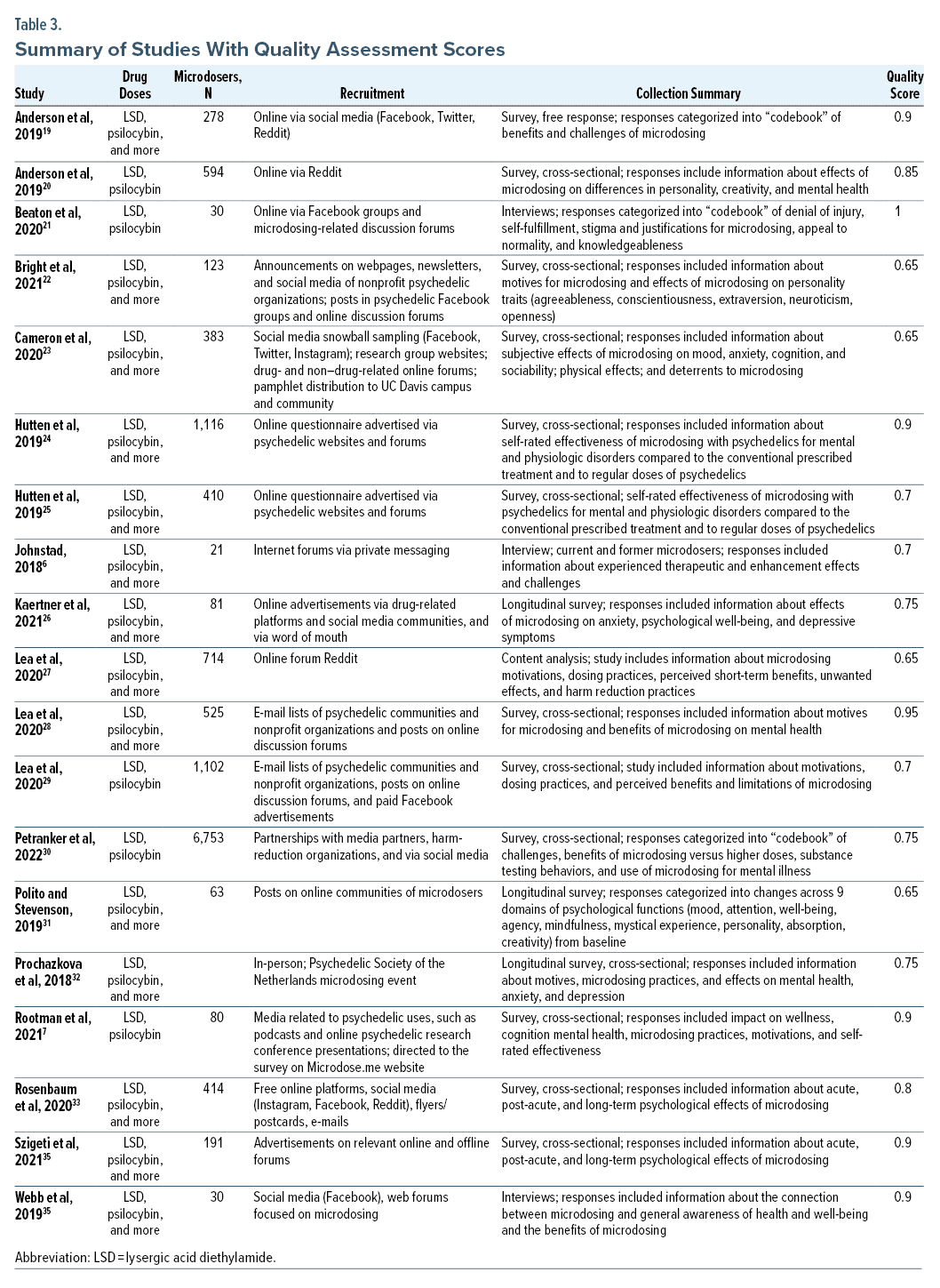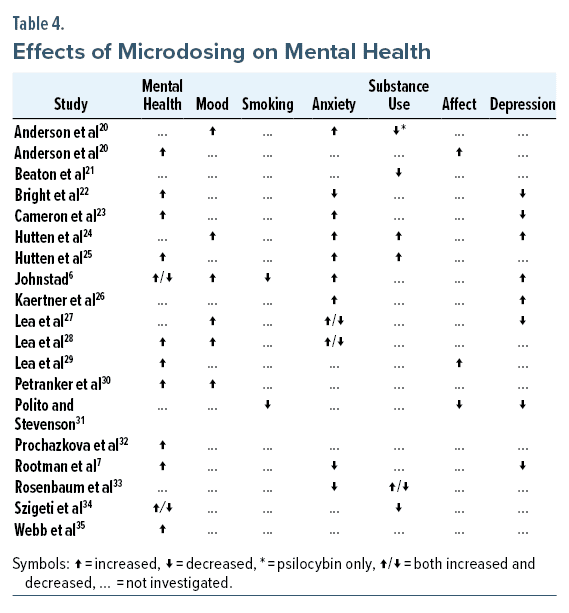ABSTRACT
Objective: To investigate the relationship between psychedelic microdosing and its effects on mental health, aiming to understand if microdosing can improve mental well-being.
Data Sources: PubMed and Scopus were searched on December 25, 2022, using search terms related to psychedelics, microdosing, and mental health. The inclusion criteria focused on studies published between January 1, 2012, and November 30, 2022. There were no language restrictions for the initial search; however, for the study selection, only articles in English were considered.
Study Selection: A total of 45 articles were initially identified. After removing duplicates, 27 unique articles were screened based on their titles and abstracts, resulting in 19 articles included in the final review. The studies were selected based on their relevance to the relationship between mental health and psychedelic microdosing.
Data Extraction: The extracted data from the selected studies included sample sizes, demographics, survey designs, and qualitative and quantitative analyses related to the outcomes of individuals with mental health issues who also engaged in psychedelic microdosing. The QualSyst Quality Assessment Checklist was used to assess the methodological rigor and quality of each study. The data extraction process involved systematically reviewing each article and summarizing key findings related to the impact of microdosing on mental health.
Results: The review revealed that microdosing psychedelics, such as lysergic acid diethylamide and psilocybin, showed potential benefits on mental health. Users reported positive effects, including improved mood, increased focus, and better daily function. However, there were also challenges reported, such as physiologic discomfort and increased anxiety. Some studies observed that positive expectations about microdosing led to positive outcomes. The studies varied in design, with some being observational, others placebo-controlled, and some relying on self-reported data.
Conclusions: There is a growing body of evidence suggesting a positive correlation between psychedelic microdosing and improved mental well-being. However, due to the limited number of controlled studies and the small sample sizes in some of the studies, the causal relationship between microdosing and mental health improvement remains uncertain. The review calls for further research with double-blind experiments, control groups, and larger sample sizes that represent the general population to better understand the potential benefits and risks of psychedelic microdosing on mental health.
Prim Care Companion CNS Disord 2024;26(1):23r03581
Author affiliations are listed at the end of this article
Mental health disorders represent a significant global concern, impacting individuals across diverse geographies and cultures. A potential intervention that has been proposed is psychedelic microdosing—the practice of regularly consuming very small doses of psychedelic substances, such as LSD and psilocybin, with the aim of improving mood, cognition, and overall well-being. In the United States, estimates suggest over 5.5 million active users have engaged in psychedelic use, with numbers increasing steadily.1 Despite its growing popularity, there is limited scientific research on the effects and correlation of microdosing with mental health due to both the legal and ethical implications of this practice. This lack of research has led to a need for more robust studies to understand the potential benefits and risks of microdosing with both a therapeutic and recreational intent.
Originally devised in 1956 by Humphrey Osmond, the term psychedelics originates from the Greek language and means psyche (“the mind or soul”) and delos (“to show”).2 Classified as hallucinogens, psychedelics can alter an individual’s perception and behavior by causing visual distortions, hallucinations, detachment from reality, and other transcendental experiences.3 Hallucinogens are divided into 2 main categories: classic serotonergic hallucinogens and dissociative drugs. Classic serotonergic hallucinogens, such as LSD and psilocybin, can lead to intense emotional fluctuations and cause perceptions of reality to become distorted, sometimes to unsettling or alarming degrees. In contrast, dissociative drugs like ketamine, phenylcyclohexyl piperidine (PCP), and dextromethorphan may elicit “out-of-body” experiences and detachment from one’s physical self.4 These compounds, which are depicted in Figure 1, interact with serotonin receptors (also known as 5-HT or 5-hydroxytryptamine receptors) and their various subtypes across the central and peripheral nervous systems.
Unlike other forms of psychedelic use, microdosing refers to the consumption of a wide range of psychedelic substances at a much lower amount of a recreational or therapeutic dose.5,6 Frequency of ingestion is typically consistent, occurring every 2 to 3 days, and lasts for long periods of time. The idea behind the delay may be due to a possible residual effect from each microdose that lasts 1 to 2 days afterward.5 Psilocybin and LSD are substances most commonly microdosed5,7; however, other drugs such as mescaline, dimethyltryptamine (DMT), amphetamines, and Salvia divinorum are also used.5
Defining the precise dosage for microdosing presents a challenge due to the absence of universally accepted criteria among scientific communities. A commonly referenced guideline suggests that a microdose ranges between one-tenth and one-twentieth of a standard recreational dose.5 This ambiguity arises from several factors. First, microdosing typically involves taking unregulated substances, which can make it difficult to identify the drug or the number of active ingredients. Second, there is a lot of variation in the effects, classes, and preparation of these substances and individual responses to them. Third, the appropriate effects of microdosing remain a subject of debate. While some individuals argue that the ideal dose should be subtle, others assert that slight shifts in consciousness are indicative of its impact. Table 1 provides a summary of the currently accepted estimated dose ranges for microdosing.
Historically, the perception of psychedelics has oscillated between acceptance and skepticism. Before 1970, studies on this topic flourished until the Controlled Substances Act prohibited and classified psychedelics as Schedule I. There has been a recent surge in popularity of microdosing, marked by an increase in anecdotal reports and media coverage of the topic. Additionally, there has been a shift in attitudes toward psychedelics, leading to more research and legal leniency surrounding their use. While most research on psychedelics has focused on their therapeutic potential, microdosing has also been studied for its effects on cognition and well-being in healthy individuals. Yet, despite the many supposed benefits, rigorously controlled studies remain limited. It is crucial, therefore, to differentiate between empirical evidence and anecdotal narratives, especially concerning mental health.
Thus, this systematic review joins the resurgence of microdosing research in investigating the scientific literature on the effects of this practice on mental health. In recent decades, there has been an undeniable escalation in mental health challenges across all demographics. There are several conditions, ranging from mood and depressive disorders and anxiety to personality disorders and PTSD, which influence one’s emotional and behavioral state.7 Studies have begun to observe the impact that psychedelic microdosing has on mental health. Full-dose use of psychedelics has shown decreased feelings of anxiety and depression, but only recently, within the past decade, have studies on the effects of microdosing been observed.
METHODS
A structured systematic review was conducted on the associations between psychedelic microdosing and mental health. Our review protocol follows the Preferred Reporting Items for Systematic Reviews and Meta-Analyses checklist for study protocols18 and was registered in the PROSPERO database (no. CRD42023462188) and in OSF (Center for Open Science). PubMed and Scopus were systematically searched for studies published between January 1, 2012, and November 30, 2022. The search strategy involved studies investigating individual and multiple psychedelics in the context of mental health and microdosing or very low dosing.
Study Identification and Selection
Overall search terms were based on key concepts such as psychedelic, microdosing, mental health, and appropriate variants. Using the Scopus syntax as an example, the following search terms were used in both databases: TITLE (“psychedelic” OR “hallucinogen” OR “LSD” OR “psilocybin” OR “DMT” OR “ibogaine” AND TITLE-ABS-KEY (“micro” OR “low” OR “mini”) AND TITLE-ABS-KEY (“dose”) AND TITLE-ABS-KEY (“mental” OR “psychological” OR “mind”) AND TITLE-ABS-KEY (“health” OR “wellness” OR “wellbeing”).
Titles and abstracts of all identified studies were reviewed. Two authors (D.F.L., H.Z.) also screened full-text articles of potentially relevant studies or those for which the abstracts did not provide sufficient information.
Any discrepancy was discussed with a third author (P.R.). For the initial search, there were no language restrictions. However, for the study selection, only articles in English were considered.
Selection Criteria of Studies and Outcome Measures
The search resulted in a total of 45 articles (27 from PubMed and 18 from Scopus). Of those, 27 unique articles were identified after accounting for duplicates. Inclusion criteria included articles from within the last 10 years; however, publication dates of the identified articles were from 2018 onward. Studies that did not mention mental health issues or psychedelic microdosing were excluded. A total of 19 articles were included in the final review. Figure 2 provides the study selection process.
The types of research articles included observational, placebo, self-reported, motivational, and comparative studies, as well as one literature review. No limitations were placed on the study types, and bibliographies were also reviewed to identify any other eligible studies.
Data Extraction, Risk of Bias, and Quality Assessment
Study type was classified according to the study design reported: (1) observational study: designed to observe the possible effects of exposure on outcomes without any interventions from the investigator; (2) placebo study: investigated whether changes in a test group are due to chance or to treatment; (3) self-reported study: involved individuals reporting their own behavior; (4) comparative study: examined the difference between 2 groups, specifically comparing those who microdose versus those who do not; (5) motivational study: observed why individuals are participating in a certain behavior; and (6) literature review: analyzed previously published studies about a particular topic within mental health and psychedelic microdosing.
In addition, the outcomes of individuals with mental health issues who also microdosed with psychedelics were examined. The articles in this review included sample sizes, sample demographics, survey design, and qualitative and quantitative analysis on targeted outcomes. Article methodology, discussion, and conclusions were extracted from the sources used. In our review, the extracted data were analyzed, extrapolated, and included in both the results and discussion sections. The type of study, qualitative versus quantitative (prospective and retrospective), was also noted, as shown in Figure 3.
As shown in Table 2, the risk of bias assessment was performed to establish the transparency of systematic review results and findings. The reviewers carried out the assessment of the risk of bias (RoB) independently, and the final quality assessment was based on consensus. They evaluated the reliability, causality, and transparency of the studies, as well as the following sources of limitation: bias due to the study design, internal and external validation, and limitations in data input. The RoB for included studies was classified as low risk, high risk, or unclear. The Cochrane Collaboration RoB tool was used to evaluate the RoB of included studies. The reviewers assessed the RoB based on attrition bias, reporting bias, and performance or detection bias. Criteria for high, low, and unclear RoB adhered to the Cochrane Handbook for Systematic Reviews of Interventions.37 The GRADE methodology38 was used to rate individual study limitations for randomized controlled trials.
In Table 3, studies were summarized and then scored using the QualSyst Quality Assessment Checklist,39 examining methodological rigor in 10 essential elements of study validity. Scores (yes: 2, partial: 1, no: 0) were tallied and then averaged by dividing by 20 (total possible score), resulting in values between 0 and 1. The minimum threshold was set to 0.60, with all studies scoring above that representing higher quality studies.
RESULTS
In 2019, Anderson et al19 developed a comprehensive codebook based on qualitative reports from 278 microdosers investigating benefits and challenges of psychedelic microdosing. Using a mixed-methods approach, outcomes included improved mood (26.6%) and focus (14.8%), alongside discomfort (18.0%) and anxiety (6.7%). Substance-dependent differences emerged, with psilocybin-only users emphasizing microdosing benefits. Later that year, the same researchers examined the mental health and personality traits of microdosers recruited from online forums. Results revealed that current and former microdosers exhibited lower dysfunctional attitudes and negative emotionality, along with higher levels of wisdom, open-mindedness, and creativity compared to non-microdosing controls.20
Beaton et al21 explored how microdosers excuse or justify their practice, employing the sociology of accounts as a theoretical framework. Drawing from semistructured interviews with 30 microdosers, the research revealed that while none provided excuses, all offered justifications. Six key justifications emerged: denial of injury, self-sustaining, self-fulfillment, appeal to normality, appeal to loyalties, and knowledgeableness.21
Bright et al22 investigated whether microdosing psychedelics and practicing yoga had similar effects on psychological well-being, depression, anxiety, and stress. The study analyzed 339 participants in different groups: yoga practitioners, microdosers, yoga practitioners and microdosers combined, and a control group. Results indicated that the combined microdosing and yoga group had the highest psychological well-being and absorption scores, with lower depression and anxiety scores compared to individual practices.22
Cameron et al23 conducted an online survey with 2,347 participants to assess microdosing prevalence and demographics and explore reasons for discontinuation. Results showed that 59% of respondents were familiar with microdosing, and 17% had practiced it. Participants reported improved mood, reduced anxiety, and enhanced memory, attention, and sociability. Reasons for discontinuation included legal risks (24.28%) and challenges in obtaining psychedelic compounds (22.63%).23
In 2019, Hutten et al24 conducted a study to investigate the motives and potential side effects of microdosing psychedelics. Through an online questionnaire, 1,116 respondents with microdosing experience were analyzed with microdosing frequencies between 2 and 4 times per week. Performance enhancement was the primary motive for microdosing (37%), and psychological effects were the most reported negative effects.24 Later that year, Hutten et al25 explored the self-rated effectiveness (SRE) of microdosing psychedelics (MDP) for mental and physiologic health problems compared to conventional treatment and regular psychedelic doses. The study found that the SRE of MDP was significantly higher than conventional treatments for mental and physiologic diagnoses, particularly for attention-deficit/hyperactivity disorder/attention deficit disorder and anxiety disorders. However, the SRE of MDP was lower than regular psychedelic doses for mental disorders such as anxiety and depression, with no difference observed for physiologic disorders.25
In 2018, Johnstad6 conducted a qualitative interview study with 21 male participants. The study revealed that participants experienced positive outcomes such as improved mood, cognition, and creativity, often countering symptoms of anxiety and depression. Microdosing was commonly practiced in phased experimentation patterns, although challenges were reported, leading some participants to discontinue the practice. The study highlighted a subgroup of users who employed microdosing to enhance daily functioning rather than for intoxication, offering insights for potential future research directions despite limitations in generalizability.6
Kaertner et al (2021)26 collected web-based mental health data before, during, and after a 4-week microdosing regimen using a prospective design. Results indicated improved psychological well-being, emotional stability, and reductions in anxiety and depressive symptoms. Traits such as psychological resilience, social connectedness, agreeableness, nature relatedness, and aspects of psychological flexibility increased. However, the study highlighted the significant role of positive expectations at baseline in predicting subsequent improvements, suggesting a notable placebo response.26
In their first article of 2020, Lea et al27 conducted a content analysis of 714 Reddit forum posts, examining discussions related to LSD, psilocybin, and other psychedelics. The study explored various aspects of microdosing, including user motivations, dosing practices, perceived short-term benefits, unwanted effects, and harm reduction strategies, providing insight into real-world experiences shared within online communities. In a subsequent study the same year, Lea et al28 expanded their research by surveying 525 participants recruited from e-mail lists of psychedelic communities, nonprofit organizations, and online discussion forums. This survey gathered responses detailing motivations for microdosing and its perceived benefits for mental health, contributing to a broader understanding of microdosing practices and their potential effects. Finally, their third article29 that year discussed an online survey, exploring the perceived outcomes of microdosing psychedelics as self-managed therapies for 1,102 microdosing respondents. Results indicated that 21% used microdosing for depression, 7% for anxiety, 9% for other mental disorders, and 2% for substance use cessation or reduction. Notably, 44% perceived “much better” mental health due to microdosing. Multivariate analysis showed associations between perceived mental health improvements and various factors, including sex, education, microdosing duration and motivations, and recent use of larger psychedelic doses.29
Petranker et al30 conducted a study focusing on subjective benefits, challenges, substance testing behavior, and the role of intention aimed to replicate previous findings on microdosing. Results from 6,753 participants showed partial replication of reported benefits like enhanced mood, creativity, focus, and sociability, but the most common challenge reported was “none.” Most participants did not test their substances, and contrary to expectations, approach-intention predicted fewer benefits rather than more.30
Polito and Stevenson31 observed 98 microdosers over 6 weeks in study 1, tracking daily psychological functioning ratings. Limited residual effects were found on non-dosing days, while dosing days showed increased psychological functioning. Pre- and post-study measures indicated reduced depression and stress, lower distractibility, increased absorption, and heightened neuroticism. In study 2, they explored preexisting beliefs and expectations about microdosing’s effects in 263 microdosers. Participants expected significant, broad benefits, contrasting with actual reported outcomes. Notably, anticipated effects did not align with observed outcomes.31
Prochazkova et al32 conducted a study to explore the potential cognitive-enhancing effects of microdosing psychedelics in healthy adults. The study focused on the effects of psychedelic truffles on convergent and divergent thinking tasks, as well as fluid intelligence. Results indicated that microdosing improved both convergent and divergent thinking but had no impact on fluid intelligence. The study suggests that psychedelics might influence cognitive meta-control policies, optimizing the balance between cognitive persistence and flexibility.32
Rootman et al7 conducted a study to examine microdosing practices, motivations, and mental health outcomes among self-selected microdosers and non-microdosers using a mobile application. The sample included 4,050 microdosers and 4,653 non-microdosers. Users exhibited similarities in demographics to non-user controls but were more likely to report a history of mental health concerns. Interestingly, microdosers with mental health concerns reported lower levels of depression, anxiety, and stress regardless of sex. Health and wellness–related motivations were prominent among microdosers, particularly among females and those with mental health concerns.7
In 2020, Rosenbaum et al33 conducted a survey to characterize the practices and demographics of microdosing individuals from Reddit participants (N = 909). Microdosers primarily used LSD (59.3%) or psilocybin (25.9%) on a 1-day-on, 2-days-off schedule. Compared to non-microdosers, microdosers were less likely to report a history of substance use disorders and anxiety disorders. However, microdosers were more likely to report recent recreational substance use.33
Szigeti et al34 conducted a self-blinding citizen science study to investigate the effects of psychedelic microdosing. The study aimed to address potential placebo effects by providing participants with instructions on how to incorporate a placebo control into their microdosing routine without clinical supervision. While both the microdose and placebo groups showed significant improvements in psychological outcomes over the 4-week dose period, no significant differences were observed between the groups. Although some minor differences were noted in acute and post-acute scales, these could be attributed to participants breaking the blind. The study34 suggests that the reported benefits of microdosing may be explained by the placebo effect.
Webb et al35 investigated microdosing of classic psychedelics using a narrative identity framework. Through interviews with 30 microdosers, they found that participants perceived their microdosing as a rational and practical pursuit, emphasizing connections to health and wellness awareness. Microdosers positioned themselves within conventional middle-class values, distinguishing themselves from recreational drug users and normalizing their practice by aligning with fellow citizens who shared similar values.35 Table 4 presents a detailed overview of the specific effects of microdosing from all included studies.
DISCUSSION
In this article, we sought to provide a comprehensive systematic review of the current literature on the relationship between psychedelic microdosing and mental health outcomes, as previous research has primarily focused on the effects of full-dose psychedelics on mental health. Recent studies suggest microdosing may offer therapeutic value for a spectrum of individuals, encompassing beginner microdosers, experienced microdosers, and cancer patients. Anderson et al20 reported potential improvements in areas such as attitude, wisdom, emotionality, and mood, which can be attributable to microdosing. This finding suggests a positive correlation between microdosing and augmented well-being. Elevated dysfunctional attitudes (such as perfectionism, catastrophizing, or overgeneralization) heighten susceptibility to stressors by perpetuating unfavorable beliefs, which in turn correlates with an increased risk of experiencing depression.20
Similarly, mental and physical problems can be indicated by tendencies to experience negative emotions.20 Anderson et al20 established a relationship between microdosing and an improvement in one’s mental state. In Johnstad’s qualitative interview study,6 respondents had better daily function when using psychedelic drugs, and common effects were health related, with a small impact on states of depression and anxiety. Microdosing helped individuals trying to enhance their everyday behavior and individuals who did not see improvement in their mental state using pharmaceuticals prescribed to them.6 One individual stated that they experienced lasting relief from depression and social anxiety and that microdosing helped greatly with manic polar depression and suicidal intentions, which correlates microdosing to better mental health.6
Since Johnstad’s study6 was an interview design, in which no control group can be established, a correlation between microdosing and improvement in mental health cannot be confirmed. An experimental study involving a control group is necessary to establish a cause-and-effect relationship between microdosing and improvements in mental health. Together, Anderson et al20 and Johnstad6 provide evidence to establish a correlation between microdosing psychedelics and an improvement in mental health outcomes.
There exist limitations in each study that should be considered when understanding their conclusions. Anderson et al20 obtained data from a group of participants who were mainly male, white, middle class, and heterosexual, while the community of microdosers was more diverse. The lack of diversity in the study introduces a barrier to the generalization of the findings. An observational study is not designed to establish a cause-and-effect relationship, only a correlational one, which leads to a weaker generalization of the study’s conclusions. Johnstad6 interviewed only males with specific characteristics that were not representative of the population, which does not allow the conclusions to be generalized to all potential users. A study involving interviews cannot establish a causal relationship—only a correlational one.
A double-blind experiment conducted by Ross et al39 established that microdosing psychedelics causes an improvement in mental health. A control group of cancer patients did not exhibit an improvement in mental health when compared to a group of cancer patients that was given psilocybin. In a follow-up assessment in the study by Ross et al,39 psilocybin reduced negative mood and well-being associated with cancer. Continued positive effects on mental health after using psilocybin is supported by the follow-up assessment.
Ross et al39 stated that a small sample size is a limitation to the trial, referring to their randomized control experiment, and that it did not represent the national cancer patient population. Although Ross et al39 established a causal relationship between microdosing psychedelics and improved mental health, the small sample size and its inability to represent the actual population make it difficult to generalize the causal relationship. A small sample size that does not represent the holistic population is present in all the studies, and all studies mention that future experiments are necessary to address shortcomings in their studies.
CONCLUSIONS
Each study contributes to the understanding of the role psychedelic microdosing plays in improving an individual’s mental health. Microdosing psychedelics is a novel topic, and current research strives to understand its use as an alternative treatment for depression and anxiety. With a small portion of individuals microdosing psychedelics, current research has struggled to design studies that establish a causal relationship between microdosing and improved mental health. Considering the conclusions from observational and qualitative studies, further research that strives to establish a causal relationship between microdosing psychedelics and mental health is warranted. Future studies designed to be double-blind, contain control groups, and have large sample sizes that represent the population will contribute to our current understanding of the topic.
Article Information
Published Online: January 16, 2024. https://doi.org/10.4088/PCC.23r03581
© 2024 Physicians Postgraduate Press, Inc.
Submitted: June 12, 2023; accepted August 30, 2023.
To Cite: Lo DF, Zia H, Rajkumar P, et al. Modern psychedelic microdosing research on mental health: a systematic review. Prim Care Companion CNS Disord. 2024;26(1):23r03581.
Author Affiliations: Department of Medicine, Rowan University School of Osteopathic Medicine, Stratford, New Jersey (Lo); American Preventive Screening and Education Association (APSEA), Stratford, New Jersey (Lo, Zia, Rajkumar, Thakur, O’Donnell); Department of Biology, Rutgers, the State University of New Jersey, New Brunswick (Lo, Zia, Rajkumar, Thakur, O’Donnell).
Notice of Correction 2/13/25: The authors have corrected text in the Results as follows: “In their first article of 2020, Lea et al27 conducted a content analysis of 714 Reddit forum posts, examining discussions related to LSD, psilocybin, and other psychedelics. The study explored various aspects of microdosing, including user motivations, dosing practices, perceived short-term benefits, unwanted effects, and harm reduction strategies, providing insight into real-world experiences shared within online communities. In a subsequent study the same year, Lea et al28 expanded their research by surveying 525 participants recruited from e-mail lists of psychedelic communities, nonprofit organizations, and online discussion forums. This survey gathered responses detailing motivations for microdosing and its perceived benefits for mental health, contributing to a broader understanding of microdosing practices and their potential effects.” (See letter of correction: https://dx.doi.org/10.4088/PCC.25lcx03941.)
Corresponding Author: David F. Lo, MBS, Department of Medicine, Rowan School of Osteopathic Medicine, 1 Medical Center Dr, Stratford, NJ 08084 ([email protected]).
Relevant Financial Relationships: None.
Funding/Support: None.
ORCID: David F. Lo: https://orcid.org/0000-0003-2408-9735; Pranetha Rajkumar: https://orcid.org/0000-0002-7052-7946); Hasan Zia: https://orcid.org/0000-0001-6304-5888); Adarsh Thakur: https://orcid.org/0000-0003-2260-5126).
Clinical Points
- Psychedelic microdosing shows therapeutic potential across a spectrum of users, from beginners to experienced microdosers to cancer patients, with positive correlations to improved attitude, wisdom, emotionality, and mood, implying a positive impact on mental well-being.
- Qualitative interviews indicate that microdosing can enhance daily functioning and mental state, especially for individuals aiming to enhance their behavior, potentially offering relief from conditions like depression, social anxiety, bipolar depression, and suicidal intentions, highlighting a plausible connection between microdosing and enhanced mental health.
- Challenges persist in participant diversity, potentially limiting generalizability, and the correlational nature of interview-based and observational studies hampers the establishment of causal relationships in the context of microdosing and mental health.
References (39)

- Hasin D. New Study Estimates Over 5.5 Million US Adults Use Hallucinogens. 2022. Accessed December 25, 2022.https://www.publichealth.columbia.edu/news/new-study-estimates-over-5-5-million-u-s-adults-use-hallucinogens
- Lowe H, Toyang N, Steele B, et al. The therapeutic potential of psilocybin. Molecules. 2021;26(10):2948. PubMed CrossRef
- Martin DA, Nichols CD. The effects of hallucinogens on gene expression. Curr Top Behav Neurosci. 2018;36:137–158. PubMed CrossRef
- Hallucinogens and Dissociative Drugs. Research report brochure. United States Department of Health and Human Services, National Institute of Health. Accessed December 25, 2022. https://nida.nih.gov/sites/default/files/rrhalluc.pdf
- Polito V, Liknaitzky P. The emerging science of microdosing: A systematic review of research on low dose psychedelics (1955–2021) and recommendations for the field. Neurosci Biobehav Rev. 2022;139:104706. PubMed CrossRef
- Johnstad PG. Powerful substances in tiny amounts: an interview study of psychedelic microdosing. Nordisk Alkohol Nark. 2018;35(1):39–51. PubMed CrossRef
- Rootman JM, Kryskow P, Harvey K, et al. Adults who microdose psychedelics report health related motivations and lower levels of anxiety and depression compared to non-microdosers. Sci Rep. 2021;11(1):22479. PubMed CrossRef
- Yanakieva S, Polychroni N, Family N, et al. The effects of microdose LSD on time perception: a randomized, double-blind, placebo-controlled trial. (published correction appears in Psychopharmacology (Berl) Psychopharmacology (Berl). 2019;236(4):1159–1170. PubMed CrossRef
- Forsyth B, Machado L, Jowett T, et al. Effects of low dose ibogaine on subjective mood state and psychological performance. J Ethnopharmacol. 2016;189:10–13. PubMed CrossRef
- Goutarel R, Golnhoffer N, Siddens R. Pharmacodynamics and therapeutic applications of iboga and ibogaine. (translated from French by Gladstone WJ). Psychedelic Monogr Essays. 1993;6:70–111.
- Strassman RJ, Qualls CR. Dose-response study of N,N-dimethyltryptamine in humans, I: neuroendocrine, autonomic, and cardiovascular effects. Arch Gen Psychiatry. 1994;51(2):85–97. PubMed CrossRef
- Shulgin AT. DMT & TMA-2. J Psychedelic Drugs. 1976;8(2):167–169. CrossRef
- Madsen MK, Fisher PM, Burmester D, et al. Correction: Psychedelic effects of psilocybin correlate with serotonin 2A receptor occupancy and plasma psilocin levels. Neuropsychopharmacology. 2019;44(7):1336–1337. PubMed CrossRef
- Griffiths RR, Johnson MW, Richards WA, et al. Psilocybin occasioned mystical-type experiences: immediate and persisting dose-related effects. Psychopharmacology (Berl). 2011;218(4):649–665. PubMed CrossRef
- Griffiths RR, Johnson MW, Richards WA, et al. Psilocybin-occasioned mystical-type experience in combination with meditation and other spiritual practices produces enduring positive changes in psychological functioning and in trait measures of prosocial attitudes and behaviors. J Psychopharmacol. 2018;32(1):49–69. PubMed CrossRef
- Hasler F, Bourquin D, Brenneisen R, et al. Determination of psilocin and 4-hydroxyindole-3-acetic acid in plasma by HPLC-ECD and pharmacokinetic profiles of oral and intravenous psilocybin in man. Pharm Acta Helv. 1997;72(3):175–184. PubMed CrossRef
- Turton S, Nutt DJ, Carhart-Harris RL. A qualitative report on the subjective experience of intravenous psilocybin administered in an FMRI environment. Curr Drug Abuse Rev. 2014;7(2):117–127. PubMed CrossRef
- Moher D, Shamseer L, Clarke M, et al; PRISMA-P Group. Preferred reporting items for systematic review and meta-analysis protocols (PRISMA-P) 2015 statement. Syst Rev. 2015;4(1):1. PubMed CrossRef
- Anderson T, Petranker R, Christopher A, et al. Psychedelic microdosing benefits and challenges: an empirical codebook. Harm Reduct J. 2019;16(1):43. PubMed CrossRef
- Anderson T, Petranker R, Rosenbaum D, et al. Microdosing psychedelics: personality, mental health, and creativity differences in microdosers. Psychopharmacology (Berl). 2019;236(2):731–740. PubMed CrossRef
- Beaton B, Copes H, Webb M, et al. Accounting for microdosing classic psychedelics. J Drug Issues. 2020;50(1):3–14. CrossRef
- Bright S, Gringart E, Blatchford E, et al. A quantitative exploration of the relationships between regular yoga practice, microdosing psychedelics, well-being and personality variables. Aust J Psychol. 2021;73(2):134–143. CrossRef
- Cameron LP, Nazarian A, Olson DE. Psychedelic microdosing: prevalence and subjective effects. J Psychoactive Drugs. 2020;52(2):113–122. PubMed CrossRef
- Hutten NRPW, Mason NL, Dolder PC, et al. Motives and side-effects of microdosing with psychedelics among users. Int J Neuropsychopharmacol. 2019;22(7):426–434. PubMed CrossRef
- Hutten NRPW, Mason NL, Dolder PC, et al. Self-rated effectiveness of microdosing with psychedelics for mental and physical health problems among microdosers. Front Psychiatry. 2019;10:672. PubMed CrossRef
- Kaertner LS, Steinborn MB, Kettner H, et al. Positive expectations predict improved mental-health outcomes linked to psychedelic microdosing. Sci Rep. 2021;11(1):1941. PubMed CrossRef
- Lea T, Amada N, Jungaberle H. Psychedelic microdosing: a subreddit analysis. J Psychoactive Drugs. 2020;52(2):101–112. PubMed CrossRef
- Lea T, Amada N, Jungaberle H, et al. Microdosing psychedelics: motivations, subjective effects and harm reduction. Int J Drug Policy. 2020;75:102600. PubMed CrossRef
- Lea T, Amada N, Jungaberle H, et al. Perceived outcomes of psychedelic microdosing as self-managed therapies for mental and substance use disorders. Psychopharmacology (Berl). 2020;237(5):1521–1532. PubMed CrossRef
- Petranker R, Anderson T, Maier LJ, et al. Microdosing psychedelics: subjective benefits and challenges, substance testing behavior, and the relevance of intention. (published correction appears in J Psychopharmacol). J Psychopharmacol. 2022;36(1):85–96. PubMed CrossRef
- Polito V, Stevenson RJ. A systematic study of microdosing psychedelics. PLoS One. 2019;14(2):e0211023. PubMed CrossRef
- Prochazkova L, Lippelt DP, Colzato LS, et al. Exploring the effect of microdosing psychedelics on creativity in an open-label natural setting. Psychopharmacology (Berl). 2018;235(12):3401–3413. PubMed CrossRef
- Rosenbaum D, Weissman C, Anderson T, et al. Microdosing psychedelics: demographics, practices, and psychiatric comorbidities. J Psychopharmacol. 2020;34(6):612–622. PubMed CrossRef
- Szigeti B, Kartner L, Blemings A, et al. Self-blinding citizen science to explore psychedelic microdosing. eLife. 2021;10:e62878. PubMed CrossRef
- Webb M, Copes H, Hendricks PS. Narrative identity, rationality, and microdosing classic psychedelics. Int J Drug Policy. 2019;70:33–39. PubMed CrossRef
- Higgins JPT, Thomas J, Chandler J, et al Cochrane Handbook for Systematic Reviews of Interventions, Version 6.4. Updated August 2023. Cochrane, 2023. Accessed December 25, 2022. www.training.cochrane.org/handbook
- Schünemann H, Brożek J, Guyatt G, et al, eds. GRADE Handbook for Grading Quality of Evidence and Strength of Recommendations. Updated October 2013. The GRADE Working Group; 2013.
- Kmet LM, Cook LS, Lee RC. Standard quality assessment criteria for evaluating primary research papers from a variety of fields. 2004. Alberta Heritage Foundation for Medical Research (AHFMR). Accessed December 25, 2022. https://www.ihe.ca/advanced-search/standard-quality-assessment-criteria-for-evaluating-primary-research-papers-from-a-variety-of-fields
- Ross S, Bossis A, Guss J, et al. Rapid and sustained symptom reduction following psilocybin treatment for anxiety and depression in patients with life-threatening cancer: a randomized controlled trial. J Psychopharmacol. 2016;30(12):1165–1180. PubMed CrossRef
Please sign in or purchase this PDF for $40.
